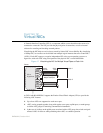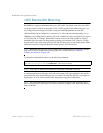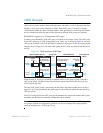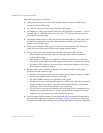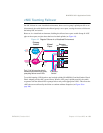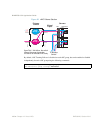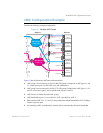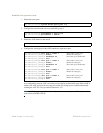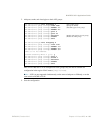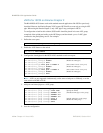BLADEOS 6.5.2 Application Guide
158 Chapter 12: Virtual NICs BMD00220, October 2010
Other vNIC group rules are as follows:
vNIC groups may have one or more vNIC members. However, any given vNIC can be a
member of only one vNIC group.
All vNICs on a given port must belong to different vNIC groups.
All members of a vNIC group must have the same vNIC pipe index. For instance, 1.1 and 2.1
share the same “.1” vNIC pipe index, but 3.2 uses the “.2” vNIC pipe index and cannot be
placed in the same vNIC group.
Uplink ports which are part of a trunk may not be individually added to a vNIC group. Only
one individual uplink port or one static trunk (consisting of multiple uplink ports) may be
added to any given vNIC group.
When a port is added to a vNIC group, flow control is disabled automatically. If the port is
removed from the vNIC group, the flow-control setting remains disabled.
For any switch ports or port trunk group connected to regular (non-vNIC) devices:
These elements can be placed in only one vNIC group (they cannot be members of
multiple vNIC groups).
Once added to a vNIC group, the PVID for the element is automatically set to use the
vNIC group VLAN number, and PVID tagging on the element is automatically disabled.
By default, STP is disabled on non-server ports or trunk groups added to a vNIC group.
STP cannot be re-enabled on the port.
Because regular, inner VLAN IDs are ignored by the switch for traffic in vNIC groups,
following rules and restrictions apply:
The inner VLAN tag may specify any VLAN ID in the full, supported range (1 to 4095)
and may even duplicate outer vNIC group VLAN IDs.
Per-VLAN IGMP snooping is not supported in vNIC groups.
The inner VLAN tag is not processed in any way in vNIC groups: The inner tag cannot be
stripped or added on port egress, is not used to restrict multicast traffic, is not matched
against ACL filters, and does not influence Layer 3 switching.
For vNIC ports on the switch, because the outer vNIC group VLAN is transparent to the
OS/hypervisor and upstream devices, VLAN tagging should be configured as normally
required (on or off) for the those devices, ignoring any outer tag.
Virtual machines (VMs) and other VEs associated with vNICs are automatically detected by
the switch when VMready is enabled (see “VMready” on page 165). However, vNIC groups
are isolated from other switch elements. VEs in vNIC groups cannot be assigned to VM groups.






